Although it produced 160,000 pounds of tractive effort, the Triplex was expensive to maintain and its boiler was notoriously hard to fire. Used primarily in helper service on Susquehanna Hill and occasionally on drag freights, the Erie P-1 class locomotives usually ran at speeds under 20 mph.
In 1916, the Erie ordered two more Triplexes and the Virginian Ry. ordered a 2-8-8-8-4 Triplex. After only four years, the Virginian rebuilt its Triplex into three locomotives. All the Erie Triplexes were retired by 1927.
The MTH model matches the dimensions of the Erie Triplex in the 1919 Simmons-Boardman Locomotive Dictionary and Cyclopedia.
The coal load in the tender is separately applied, but some chunks measure one HO scale foot across.
Paint coverage on the model is smooth. The boiler on our sample is painted in a glossy, gray-blue color to depict Russian iron. The lettering and cab numbers match prototype photos. The superheater patent plates and Baldwin builder’s plates are legible under magnification.
Without any traction tires, our sample pulled the equivalent of 67 HO freight cars on straight and level track. Replacing the rear drivers of the middle engine with the included traction-tire-equipped set increased the drawbar pull to the equivalent of 150 cars.
The model can negotiate curves as tight as 22″, since both engines under the locomotive boiler are articulated. On the prototype, only the front engine under the boiler was articulated. The MTH Triplex looks much better rounding broader curves.
When handling the model, you should support the front of the engine from underneath. The steam pipe on the front engine of our sample had slipped out of its slot under the boiler, causing the rear drivers of the front engine to lift off the rails. This has been reported by others who received the model. The problem was easily fixed by using a jeweler’s screwdriver to push the pipe back into the slot.
At 7.5 volts the model crept along at 2.5 scale mph and at 12 volts reached 20 scale mph, which is within the prototype’s speed range.
The model is designed to operate on up to 24 volts, which is above the 16-volt maximum for HO DC power packs as specified in National Model Railroad Association Recommended Practice RP-9. Using an LGB power pack I tested the model from 16 to 24 volts, where it reached its top speed of 70 scale mph.
For DCC operation, the Triplex supports 128 speed steps. I tested the model with a Model Rectifier Corp. Prodigy Advance system that supplies 16.4 volts to the track. Slow speed performance was impressive in DCC, as the Triplex started moving in speed step 1 at 1 scale mph. Again the model reached a top speed of 70 mph, but speed control is noticeably more precise at slower speeds.
The model’s 28-function DCC decoder lets you control effects such as the bell and whistle and turn the lights and smoke on or off. The instruction sheet lists only 10 programmable configuration variables, limiting the user’s ability to fine-tune the model with DCC.
The Triplex ran well using DCS. The thumbwheel throttle increased or decreased the speed in accurate 1 scale mph increments displayed on the LCD screen.
The DCS Commander can be connected to a DC power pack or DCC system but will only control DCS-equipped locomotives. To use the Commander to run DCS-equipped models and conventional or DCC-equipped models in the same block, you have to toggle between DCS mode and conventional or DCC (called Pass-through) mode. You can’t run a DCS-equipped locomotive in DCS mode simultaneously with a conventional or DCC-equipped locomotive in the same electrical block.
The sound effects include multi- part dialogue between the engineer and fireman and a fun train wreck scenario. A master volume control knob and smoke unit on/off switch are under the tender’s coal load.
Standout sounds and details makes the MTH Triplex a fine depiction of a unique prototype.
Price: $499.95
Manufacturer
MTH Electric Trains
7020 Columbia Gateway Drive
Columbia, MD 21046-1532
www.mth-railking.com
Description: Die-cast metal and plastic sound-equipped ready-to-run locomotive
Paint schemes: Erie (Russian iron) nos. 5014, 5015, 5016; Erie Black) nos. 5014, 5015, 5016; Virginian no. 700
Automatically switches between DC, Digital Command Control (DCC), or MTH Digital Control System (DCS)
Constant-voltage headlight
Die-cast metal construction
Drawbar pull: 4.8 ounces
Engine and tender weight:
2 pounds 2 ounces
Front and rear scale-size magnetic knuckle couplers (mounted at correct height)
Five-pole skew-wound motor with flywheel
Illuminated marker lights and cab interior
Minimum radius: 22″
MTH Proto-Sound 3.0 operates in DC, DCC, or DCS
NMRA RP-25 contour metal wheels (in gauge)
Operating fan-driven smoke unit
Sprung drive wheels
24-wheel electrical pickup
User-installed traction-tire- equipped (or plain) drivers





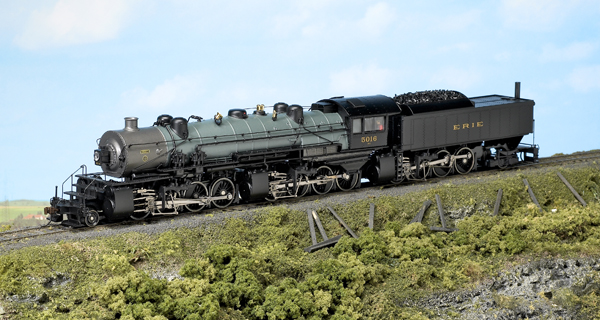
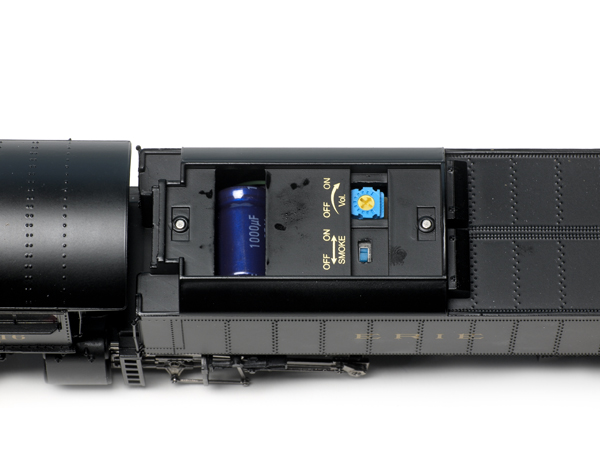
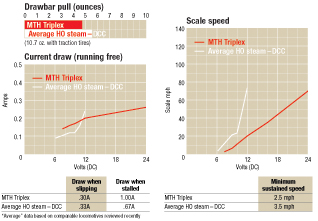

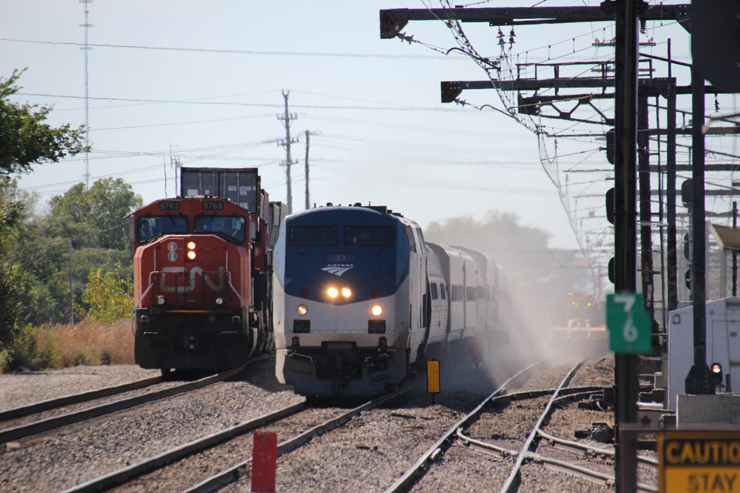
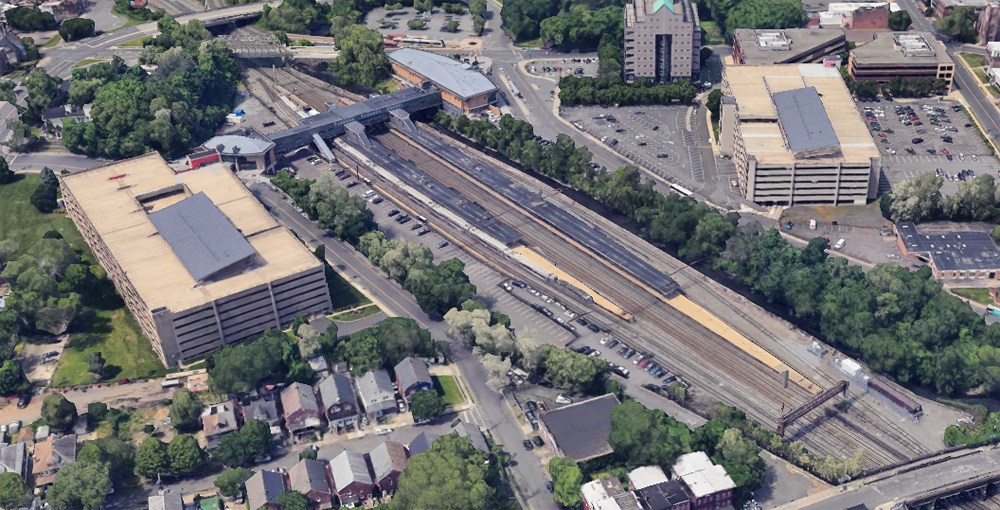
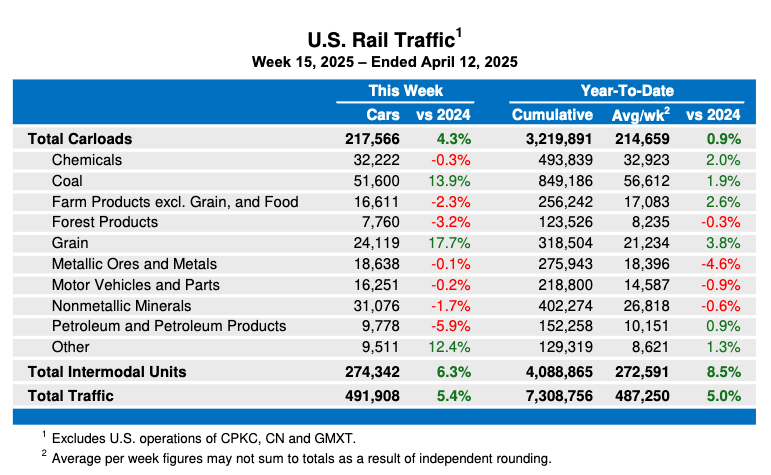




Just received the newest version and it is simply amazing, great sounds, detail and it just looks cool.
I would love to own it. Sounds like an awesome loco. Just not enough money to perchase.
i just ordered two of them that will be in 1/15/11 so i hope they are going to pull all of 150 old dumper cars that i have i can't wait
need to get a triplex erie, they are a must for any eastern railroad .
So sad, have Lexus eyes, Yugo pocketbook.
Have just watched the video and it's awesome. My own Triplex arrived a couple of weeks ago but, being busy on my garden railway, I've not had a chance to run the Triplex – but just looking at the model it's great………….
I have one and it is the nicest running loco I own. Everytime MTH comes out with a new HO engine I am compeled to purchase it. I love running these machines on DCS. It makes all the difference in the world.
nice steam engine
Please tell me there is a chance that MTH will do
the VIRGINIAN version. I would love to run that
beauty on my RR. I am impressed.
Although a rarity in the real & modeled world, there is no doubt a fascinating allure to this beast. The HO model does far better than the prototype ever could. Too bad the VIRGINIAN Triplex is incorrect, as it was a 2-8-8-8-4. I'm guessing that the correct trailing tender truck could be added wuthout too much trouble…? Sure beats the price of a brass Triplex. Be the 1st on your block to own one!!!
My wife and I own several sound models but this has to be the Ultimate to date both in sound and detail for the price you wouldnt entertain brass.
Terry & Maderleine Lockley
Hobart-Tas.
a very unique piece of history,a very good addition to a history buff's collection
Who the heck is Leroy?
"Notoriously hard to fire," no wonder with 12 inch lumps of coal in the tender.
Great looking model & of something new for a change.
MTH seems to have a nice feel for their models and the sound system is outstanding! The only complaint I have is I wish they built their models so that a DCC system would access all the features accessed only by their propriety DCS system at this time i.e. eliminate the DCS as part of a run,as of now you have to use their DCS to gain to all features built in to their product.
Someday……
I don't own one, but in my future, I plan to buy and own one. Awesome steam locomotive.
I have not bought one yet,but you can bet I will!This is the Greatest hobby on the Planet Earth.
my brother bought one and loved it!although,i dont ever see a 500.00 loco in my future 😉